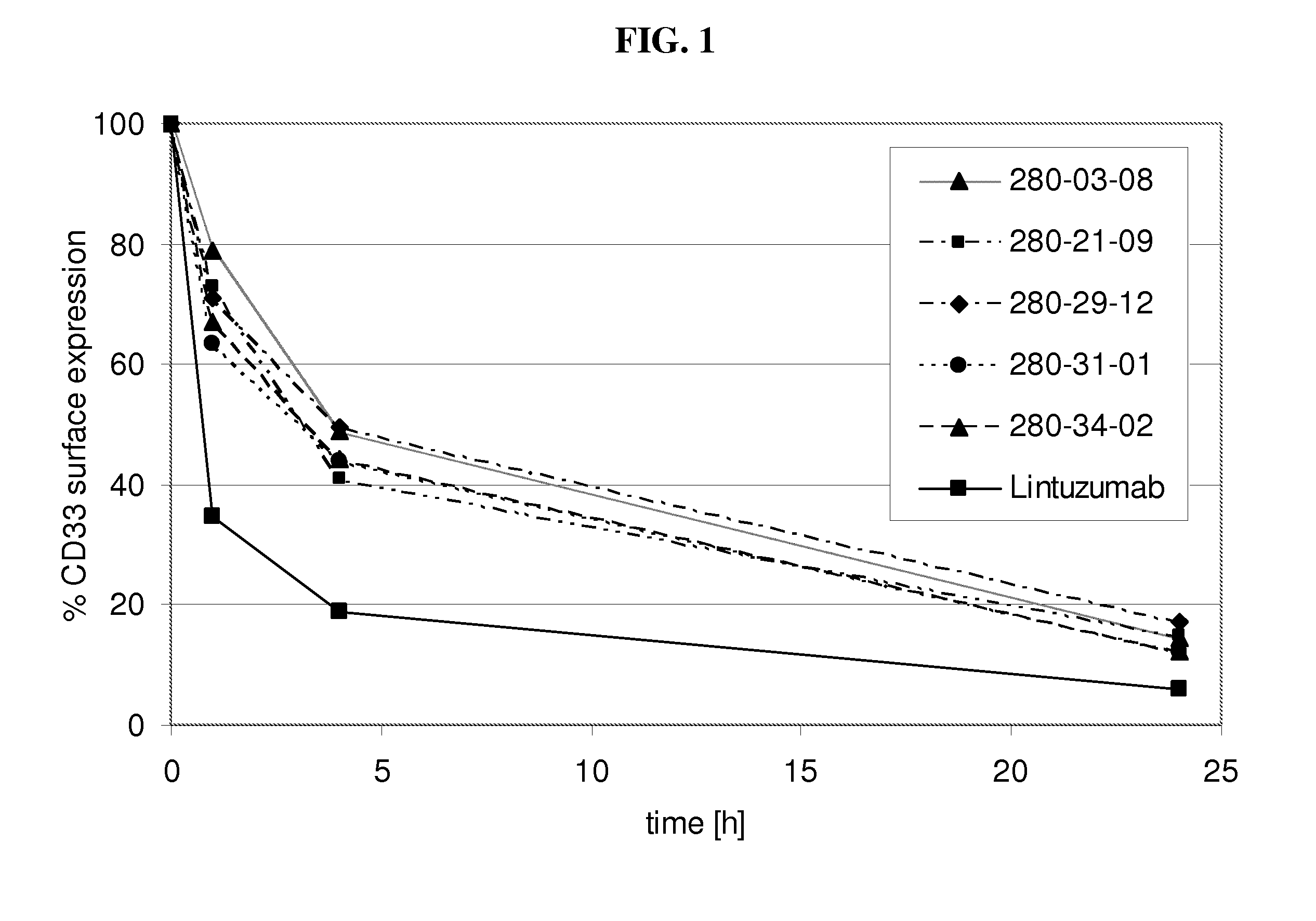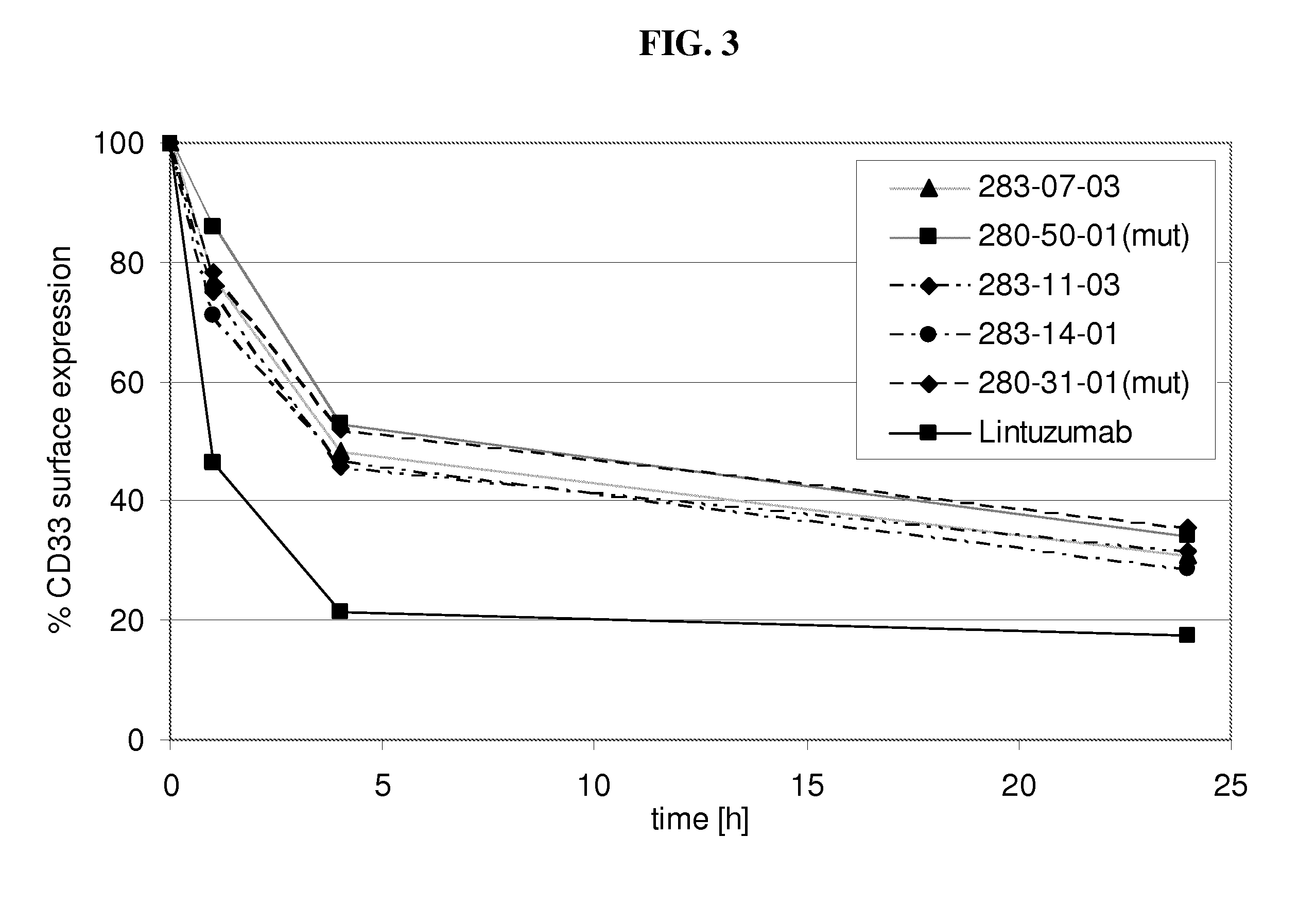Cd33 binding agents
a technology of cd33 and binding agent, which is applied in the field of immunotherapies, can solve the problems of expected improvement and discontinued clinical development of lintuzumab, and achieve the effects of favourable adcc activity, high affinity, and favourable internalization kinetics
- Summary
- Abstract
- Description
- Claims
- Application Information
AI Technical Summary
Benefits of technology
Problems solved by technology
Method used
Image
Examples
example 1
Affinitity to CD33
[0200]The CD33 binding agents have a KD to both human and cynomolgus CD33 of Affinities of 10 nM or less on the cell line HL60 and HEK293-cynomolgus CD33, respectively.
[0201]Fourteen CD33 binding agents (fully human monoclonal antibodies as listed in table 1 as No. 1-14, respectively) to human and cynomolgus CD33 were determined by FACS Scatchard analysis as described in Brockhoff et al., (Cytometry. 1994 Sep. 1; 17(1):75-83) on CD33 expressing cells (AML-derived HL60 cell line, recombinant HEK293-cynomolgusCD33 cell line). Briefly, dilutions of a CD33 binding agent were prepared in a 96 well plate starting with 100-400 nM in the first well (80 μl), followed by 11 dilution steps (1:2, 40+40 μl). 50 μl of CD33 binding agent dilutions are added to FACS tubes, 150 μl cells (0,8×106 / ml=1,2×105 cells / tube) are added to each FACS tube. Cells were gently mixed and incubated for 1 h on ice. Thereafter 50 μl FITC conjugated secondary antibody (concentration 15 μg / ml; mouse ...
example 2
[0202]Internalization of antibody refers to the reduction of the amount of antibody / antigen complexes on the cell surface of the target cell after incubation with antibody. Internalization tests were performed with the CD33 expressing HL60 cell line. Cells were incubated with a fixed amount of a CD33 binding agent (10μg / ml of fully human monoclonal antibodies as listed in table 1 as No. 1-14) for defined time periods (0 h, 1 h, 4 h, 24 h) at 37° C. to allow internalization of the antibody / antigen complex. At the indicated time points acid was added to the incubation mix to prevent further internalization. Thereafter a fixed amount of CD33 binding agent was added to saturate all CD33 antigen sites on the cell surface. The total amount of CD33 binding agent bound to the cell surface was determined by FACS analysis utilizing a FITC conjugated anti-human IgG secondary antibody. The time point 0 h was used to determine the initial level of CD33 antibody / antigen co...
example 3
ADCC Activity
[0204]Decelerated internalization rate translates into increased ADCC activity in vitro. To assess the effect of decelerated internalization on the ADCC activity of the CD33 binding agents (fully human monoclonal antibodies as listed in table 1 as No. 1-14), target cells (HL60) were incubated with a CD33 binding agent for the 0, 1, 4 and 24 h. Subsequently an ADCC assay was performed with IL-2 stimulated PBMC as effector cells and antibody coated HL60 cells as target cells. For all experiments a mAb concentration of 30 μg / ml used. The co-cultivation of effector cells with target cells in presence of CD33 binding agent was performed in quadruplicates or triplicates in 96-well round-bottom microtiter plates in a final volume of 200 μl assay medium per well consisting of 10% human serum and 1% BSA in RPMI in 1:1 ratio. First effector cells (freshly isolated PBMC cells in 100 μl 10% human serum in RPMI per well) were plated, followed by target cells and CD33 binding agent s...
PUM
| Property | Measurement | Unit |
|---|---|---|
| Fraction | aaaaa | aaaaa |
| Fraction | aaaaa | aaaaa |
| Fraction | aaaaa | aaaaa |
Abstract
Description
Claims
Application Information
 Login to View More
Login to View More - R&D
- Intellectual Property
- Life Sciences
- Materials
- Tech Scout
- Unparalleled Data Quality
- Higher Quality Content
- 60% Fewer Hallucinations
Browse by: Latest US Patents, China's latest patents, Technical Efficacy Thesaurus, Application Domain, Technology Topic, Popular Technical Reports.
© 2025 PatSnap. All rights reserved.Legal|Privacy policy|Modern Slavery Act Transparency Statement|Sitemap|About US| Contact US: help@patsnap.com



